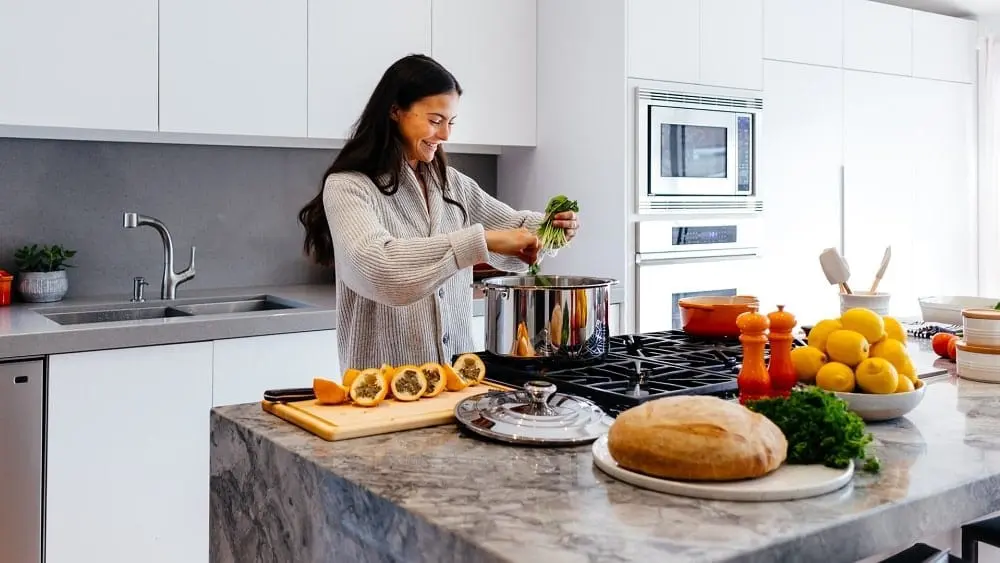
Clothing fashions may change every season, while home designs adjust a little more gradually.
Innovations in residential design depend on technology, product designs, the imaginations of interior designers and architects and research into the lifestyle and priorities of new-home buyers.
“There are a few common societal trends driving change in new homes today,” says Douglas Smith, president of Miller & Smith, a regional homebuilder based in McLean, Va. “Most important is the time constraint that everyone feels, which means we all want things in our homes to make our lives easier.”
Smith also says that people have more casual lifestyles than in the past and expect their homes to reflect their lack of formality.
What’s In
Smart Home Technology
“The biggest, fastest change we’re seeing in new homes is the use of technology,” says Sabine H. Schoenberg, founder and host of Sabine’s New House in Greenwich, Conn. “Consumers are embracing smart home features for energy efficiency and safety and security, with entertainment a distant third priority.”
Smith says wireless technology like door locks you can control with an app and Nest “learning” thermostats make life easier for homeowners and are embraced by both younger and older buyers.
Entertaining in the Kitchen
Kitchens have become the showplace of the home and the largest area of the house, says Smith, now that everyone entertains casually.
“The more open your floor plan, the better you want your kitchen to look,” says Schoenberg. “Kitchen islands are getting bigger and are being designed for multifunctional use with materials that are anti-microbial and stain resistant.”
Flexible Rooms
Smith says he likes to put a flexible space on each level, such as a home office on the first floor that can morph into a guest room or a dining room and a play room that can become a study upstairs.
Schoenberg says a room with a big table can function as an office and then be cleared for occasional use as dining room.
“I think it’s smart to set up every room with pocket doors or a barn door so you can have your whole first floor open or you can close some off for separation,” says Schoenberg.
Low-Maintenance Materials
“Another time-saver for downsizing buyers and for busy young families is that homes can be built with materials that don’t need to be constantly painted or maintained,” says Smith. Granite counters, Hardie Plank siding and even longer-lasting paint reduce the workload for homeowners.
Cleaner Exterior Style
Buyers like a clean look, such as white bricks, on the outside of their house and prefer a farmhouse-style with cream, white, blue and gray colors rather than the multiple colors and dark trim found on Craftsman-style homes, says Megan Harris, director of design for Edward Andrews Homes in Atlanta.
Rustic Touches
Homes with natural wood beams and even natural wood ceilings were among the winners of the Best in American Living Awards at the National Association of Home Builders’ 2017 International Builders Show.
“I like to use barn doors made of authentic old wood as counterpoint to the sleek cabinets in a modern kitchen,” says Schoenberg. “Sometimes I add glass panels like French doors for a more contemporary look. It’s nice to have an accent of something rustic in a modern house to add the idea of history.”
Blending Outdoor and Indoor Living
“Buyers are adding covers or screens to their outdoor spaces so they can use them year-round,” says Harris. “They also like direct access from the master suite, as well as living areas to a patio or porch.”
Outdoor fireplaces and fire pits are popular, along with walls of glass doors for visual connections between indoor and outdoor rooms, says Smith.
“We’ve brought back screened porches even for townhouses because people want to use them in three seasons,” says Smith.
Schoenberg says outdoor TVs and speakers are also popular for entertaining outside.
Hybrid Interior Design
Harris says buyers like a contemporary look, but prefer to tone it down for themselves. For instance, in a modern farmhouse, they’ll have a traditional cabinet, but painted white, and with a modern handle and an industrial-looking faucet.
“Millennials take more risks, are creative and willing to mix different colors and design styles,” says Smith. “They rarely choose something completely traditional or purely Southern in style.”
What’s Out
Wood-Burning Fireplaces.
“Most new floor plans don’t have a fireplace,” says Harris. “This gives buyers the flexibility of having different built-ins as a focal point, such as floating shelves or bookcases.”
Some buyers like a modern electric fireplace in place of a traditional fireplace.
“It’s inconceivable to people interested in green building to put in a wood-burning fireplace, because it puts a hole in the home’s energy efficiency,” says Schoenberg. “Linear gas fireplaces with crystals in the bottom are here to stay because it gives the visual impact of flames and it’s also safer around children.”
Clutter
Buyers want to see efficiency in every aspect of their new homes, says Schoenberg, so closet systems and organizers are very popular. Organizers built into kitchen cabinets and drawers are also desirable.
Standard Bathtubs
“Most buyers want a larger, more luxurious shower rather than a big soaking tub,” says Harris. “If they have the space, they’ll put in a freestanding tub rather than a drop-in tub.”
Dark Hardwood Flooring
While staining wood floors darker was popular earlier in this century, now the trend has reverted to lighter wood tones with gray, blond and white-washed treatments. Harris says wide planks are also popular.
Whether you like what’s in or what’s out, the beauty of buying a newly built home is that you can personalize it to your taste.

Michele Lerner is an award-winning freelance writer, editor and author who has been writing about real estate, personal finance and business topics for more than two decades.
 How to Create a Spa-Style Bathroom
How to Create a Spa-Style Bathroom